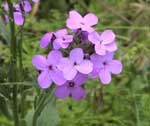Dame’s Rocket
Hesperis matronalis
Keys to Identification
-
Dame’s Rocket is a member of the Mustard Family (Brassicaceae) This escaped ornamental is beginning to show up in our wildlands.
-
This native of Europe may be either a biennial or perennial, and may be from 1-1/2 to 4 feet tall, flowers range in color from white to pink to purple. Dame’s Rocket flowers from April through July. This plant tends to invade riparian and wetland habitat. There are many alternatives to planting Dame’s Rocket including Blue Columbine (Aquilegia caerulea) and Lavender Native Bee Balm (Monarda fistulosa menthaefolia).
This information courtesy of the Colorado Natural Areas Program.
Family
Mustard (Brassicaceae)
Other Names
Sweet rocket, dame’s violet
USDA Code
HEMA3
Legal Status
Colorado Noxious Weed List B
Identification
Lifecycle
Biennial or short-lived perennial
Growth form
Forb
Flower
Flowers are white or purple with 4 petals. Flowers are clustered in loose terminal stalks. May-Sept.
Seeds/Fruit
Fruits are many seeded, long and narrow and approximately cylindrical. Seeds are small (3-4 mm long), angular, grooved and dark reddish-brown (Stubbendieck et al. 1995).
Leaves
Leaves are alternate, 2-4 in long, lance-shaped, with finely toothed margins.
Stems
Mature plants range from 4 in to 3 ft tall.
Roots
Shallow fibrous root system.
Seedling
No information available.
Impacts
Agricultural
No information available.
Ecological
Dame’s rocket is commonly planted as an ornamental, but quickly escapes cultivation because of its prolific seed production (Wisconsin DNR 1998). It is thought to be a limited invasive species that will readily invade disturbed ground but is rarely found in undisturbed areas.
Habitat and Distribution
General requirements
Dame’s rocket prefers moist soils that have a pH range of 6-7.5. It is commonly found in gardens, partly shaded woodlands, ditches, and other areas that have moist soils and light shade (Perry 1997). Dame’s rocket is often found along roadsides, pastures, rangelands, thickets and open woods.
Distribution
Found throughout the northern United States.
Historical
Dame’s rocket is native to Eurasia and is sold as a garden ornamental. Part of its success can be attributed to its wide distribution in “wildflower” seed mixes (Wisconsin DNR 1998). Dame’s rocket is not widely recognized as an invasive species. Consequently, it may not be recognized as a problem until it is well established (Wisconsin DNR 1998).
Biology/Ecology
Lifecycle
Dame’s rocket generally produces a basal rosette the first year, and flowers the following year. The plants are prolific bloomers and produce large quantities of seed from May through July. Individual plants may have several clusters of flowers at various stages of development, enabling the plant to produce both flowers and seeds at the same time (Wisconsin DNR 1998).
Mode of reproduction
Reproduces by seeds.
Seed production
Produces large quantities of seed.
Seed bank
The majority of the seeds will germinate the following year, but some seeds may remain dormant for several years.
Dispersal
An escaped ornamental.
References
Wisconsin DNR. 1998. Dame’s Rocket, (Hesperis matronalis). Exotic species factsheet. Wisconsin Department of Natural Resources. Available: http://www.dnr.state.wi.us/org/land/er/invasive/factsheets/dames.htm
Perry, Leonard.1997. Hesperis matronalis, Plant lecture list for PSS 123. University of Vermont. Internet 2/2/99. Available: http://pss.uvm.edu/pss123/wmhesp.html
Stubbendieck, J., G.Y. Friisoe and M.R. Bolick. 1995. Damesrocket. Weeds of Nebraska and the Great Plains. Nebraska Department of Agriculture, Bureau of Plant Industry, Lincoln, Nebraska. pg. 211.


